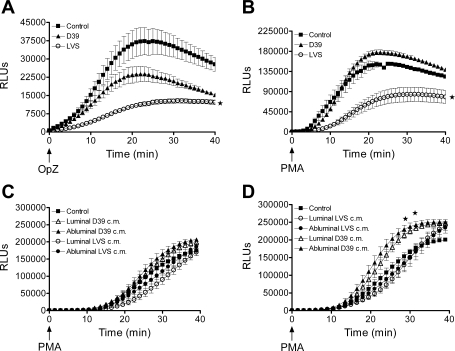Fig. 4.
NADPH oxidase activity of transmigrated PMN as measured by lucigenin-enhanced chemiluminescence in relative luminescence units (RLUs). A: after transendothelial migration in response to Ft LVS, NADPH oxidase activity in PMN was significantly depressed in response to the phagocytic stimulus opsonized zymosan (OpZ) compared with control PMN or PMN that migrated in response to Streptococcus pneumoniae strain D39. Values are means ± SE (n = 5–8). *P < 0.05 vs. control and D39 (by 2-way ANOVA). B: response to PMA (10 ng/ml) was significantly increased in control PMN and PMN that migrated in response to D39 compared with PMN that migrated in response to Ft LVS. Values are means ± SE (n = 6). *P < 0.05 vs. control and D39. C and D: PMN incubated with bacteria-endothelial cell-conditioned medium for 1 and 3 h, respectively. There was no alteration in PMN NADPH oxidase activity in response to PMA after 1 h of incubation with bacteria-endothelial cell-conditioned medium from the luminal or abluminal compartment of monolayers exposed to Ft LVS (LVS) or S. pneumoniae (D39). After 3 h of incubation, NADPH oxidase activity was significantly enhanced in PMN exposed to D39-endothelial cell-conditioned medium compared with control PMN or PMN exposed to Ft LVS-endothelial cell-conditioned medium. Values are means ± SE (n = 3). *P < 0.05 vs. control and LVS.

